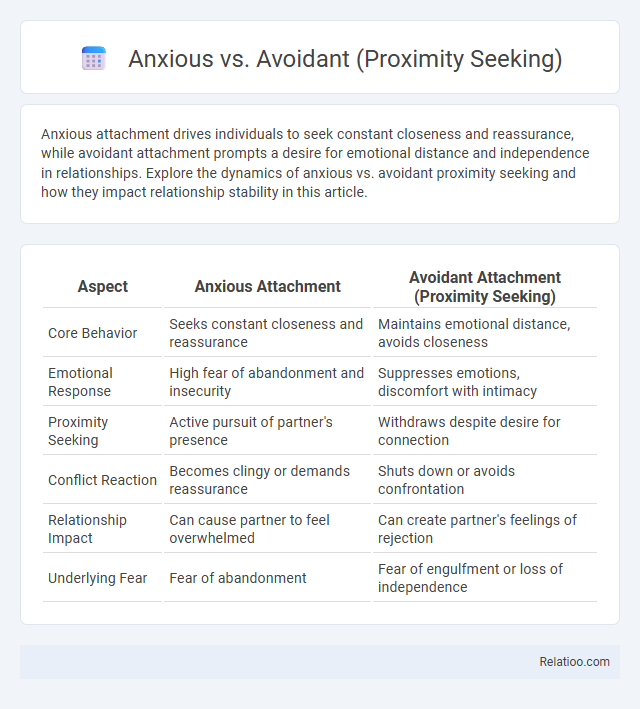Anxious attachment drives individuals to seek constant closeness and reassurance, while avoidant attachment prompts a desire for emotional distance and independence in relationships. Explore the dynamics of anxious vs. avoidant proximity seeking and how they impact relationship stability in this article.
Table of Comparison
| Aspect | Anxious Attachment | Avoidant Attachment (Proximity Seeking) |
|---|---|---|
| Core Behavior | Seeks constant closeness and reassurance | Maintains emotional distance, avoids closeness |
| Emotional Response | High fear of abandonment and insecurity | Suppresses emotions, discomfort with intimacy |
| Proximity Seeking | Active pursuit of partner's presence | Withdraws despite desire for connection |
| Conflict Reaction | Becomes clingy or demands reassurance | Shuts down or avoids confrontation |
| Relationship Impact | Can cause partner to feel overwhelmed | Can create partner's feelings of rejection |
| Underlying Fear | Fear of abandonment | Fear of engulfment or loss of independence |
Understanding Attachment Styles: Anxious vs Avoidant
Understanding attachment styles reveals that anxious individuals tend to seek constant proximity to partners due to fear of abandonment, while avoidant individuals often distance themselves to maintain independence. Your ability to recognize these patterns in proximity seeking can improve relationship dynamics by addressing emotional needs and communication styles. Insight into anxious versus avoidant behaviors helps tailor support strategies that foster secure attachment and emotional resilience.
Defining Proximity Seeking in Relationships
Proximity seeking in relationships refers to the behavior individuals exhibit to maintain physical or emotional closeness with attachment figures, crucial for security and comfort. Anxious attachment often leads to heightened proximity seeking due to fear of abandonment, while avoidant individuals tend to resist closeness, minimizing such behaviors to maintain independence. Understanding your proximity seeking patterns can help improve relational security and emotional connection.
Core Traits of Anxious Attachment
Anxious attachment is characterized by a heightened need for proximity and reassurance, often driven by fear of abandonment and intense emotional dependence, leading to persistent worries about relationship stability. Unlike avoidant attachment, which involves distancing behaviors and discomfort with closeness, anxious individuals actively seek closeness and validation to soothe their insecurity. Core traits of anxious attachment include hypervigilance to relationship cues, emotional sensitivity, and a strong desire for intimacy balanced by fears of rejection and abandonment.
Core Traits of Avoidant Attachment
Avoidant attachment is characterized by a strong emphasis on self-reliance, emotional distance, and discomfort with closeness, leading individuals to suppress their attachment needs and avoid proximity seeking behaviors. Unlike anxious attachment, which involves intense proximity seeking and fear of abandonment, avoidant individuals prioritize independence and often downplay the importance of emotional connection. Core traits include reluctance to depend on others, discomfort with intimacy, and a tendency to minimize expressions of vulnerability or attachment needs.
Proximity Seeking Behaviors: Anxious vs Avoidant
Proximity seeking behaviors differ significantly between anxious and avoidant attachment styles, with anxious individuals exhibiting heightened efforts to maintain closeness and reassurance, often displaying clinginess and persistent contact attempts. Avoidant individuals typically minimize proximity seeking, showing discomfort with intimacy and a tendency to withdraw or distance themselves when closeness is attempted. These contrasting patterns highlight the underlying emotional regulation strategies, where anxious attachment is driven by fear of abandonment, and avoidant attachment stems from fear of dependence or engulfment.
Emotional Responses to Closeness and Distance
Anxious attachment triggers intense emotional responses to closeness, characterized by heightened sensitivity to perceived rejection and a strong desire for reassurance and proximity. Avoidant attachment involves emotional distancing behaviors, where individuals suppress attachment needs and exhibit discomfort with closeness, favoring self-reliance and emotional detachment. Proximity seeking in attachment theory represents the active approach to maintaining contact and emotional connection for security, varying between anxious individuals who seek excessive closeness and avoidant individuals who minimize it, shaping their distinct emotional responses to intimacy and distance.
Communication Patterns and Misunderstandings
Anxious attachment often leads to intense proximity seeking driven by a fear of abandonment, resulting in communication patterns marked by frequent reassurance requests and heightened emotional expression. Avoidant attachment displays proximity seeking through subtle means or withdrawal, causing misunderstandings as partners interpret detachment as disinterest or rejection. Your communication can improve by recognizing these distinct patterns, fostering empathy, and promoting clearer, more consistent dialogue to bridge gaps caused by these contrasting attachment styles.
Impact on Relationship Satisfaction and Stability
Anxious attachment drives intense proximity seeking, often resulting in heightened relationship stress and lower satisfaction due to fear of abandonment. Avoidant attachment suppresses proximity seeking, leading to emotional distance and decreased relationship stability as partners struggle with intimacy. Balanced proximity seeking, rooted in secure attachment, fosters mutual support and trust, significantly enhancing relationship satisfaction and long-term stability.
Navigating Conflict: Strategies for Each Attachment Style
Anxious attachment style often results in heightened proximity seeking during conflict, driven by fears of abandonment and a strong need for reassurance, which can lead to intense emotional expressions and persistent demands for closeness. Avoidant attachment, in contrast, typically manifests as a reluctance to seek proximity when conflicts arise, favoring emotional distance and disengagement as a protective strategy to maintain autonomy. Effective navigation of conflict requires recognizing these patterns: encouraging open communication and consistent reassurance for anxious individuals, while fostering a safe space that respects boundaries without triggering withdrawal in avoidant individuals.
Healing and Growth: Moving Toward Secure Attachment
Anxious attachment drives individuals to seek constant proximity for reassurance, often resulting in heightened emotional dependency, while avoidant attachment causes discomfort with closeness, leading to withdrawal from intimacy. Proximity seeking behaviors vary, with anxious types craving closeness and avoidant types distancing themselves, both rooted in early relational patterns. Healing and growth involve recognizing these tendencies and working toward secure attachment by fostering trust, emotional regulation, and balanced interpersonal boundaries.

Infographic: Anxious vs Avoidant (Proximity Seeking)
 relatioo.com
relatioo.com